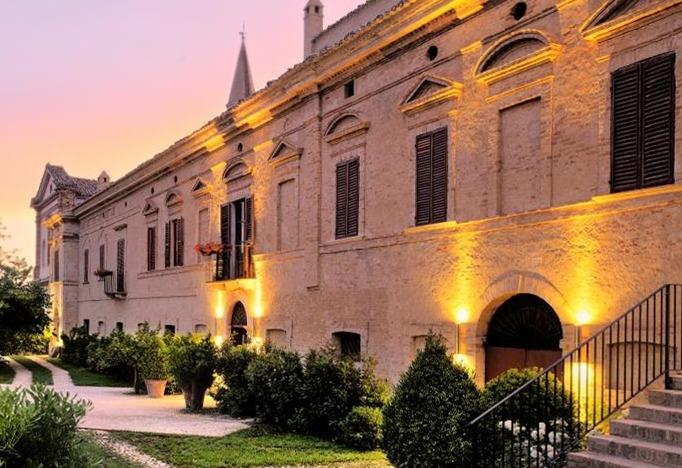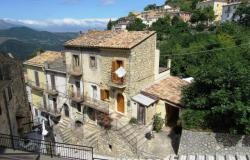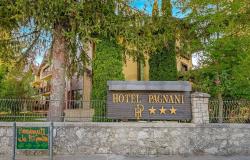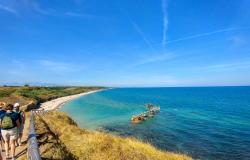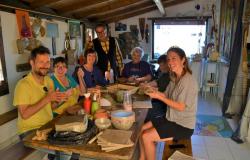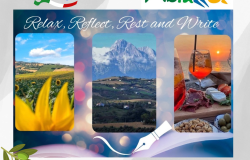Lemon blossoms scented the evening as lightly as blonde hair on a pillow at the Castello di Semivicoli high above the sea in the Abruzzo province in Italy. And, there was almost no one there but me. My train had gotten in late, the road up the mountains had been pitch black, and for the moment I was the only guest. But soon I was enveloped in that special welcome known only to those who arrive after hours, as the night receptionist ushered me upstairs to the kitchen, where candles cast a copper glow. Because no restaurants nearby were open at that hour, and the Castello has none, she had prepared a scrumptious late supper for me all kinds of local salamis and cheeses and my choice from among the Castello’s signature wines. I chose the excellent Montepulciano d’Abruzzo and settled into my room. How could I not feel like the castello’s original baroness?
In fact, my grandmother had always told our family she had been raised by a baroness in a palazzo like this one, and it was not a major leap of fantasy for me to think that I had returned to the very same spot of my family roots. One day I will do that research, but for this trip it was enough to savor this palazzo and its environs. For the rustic largely unsung Abruzzo region seeks to define itself as a place that lovingly protects its architectural heritage and landscape so that the visitor feels as comfortable as if he or she too has been born in this place, and able to travel in harmony with time and nature.

Strategically situated between formidable mountains and the many harbors of the Adriatic sea, Abruzzo can be forbidding and remote at first glance. Every valley, it seems, had its own fortress and guardhouse, many still standing, and the tendency of the region for centuries was to keep visitors and strangers out.
Today, these symbols are meant to work in reverse, and throughout Abruzzo, welcoming arms are opening, and Semivicoli is a true Shangri-La, set high above, with a sweep and panorama from mountains to sea that puts one in the mind of heaven.
The Castello was built in the 17th century and later served as the residence for the Perticone family, who were leading wine growers and farmers. So as not to be seen by the locals at prayer, the family had a private entrance to the church next door built into their master bedroom which still leads to a discreet balcony overlooking the sanctuary and guests so inclined can attend church services in utter privacy.
Eventually, the building fell on hard times, but was purchased by entrepreneur Gianni Maschiarelli in 2004. He and his wife, Marina, undertook a major renovation, bringing back all ancient details including the interior olive press, and to sleep in any of the rooms is to dream in the stately past, especially to top floor Granary suite, which offers a breathtaking 360 degree view of the region and takes up the entire top floor. But the hotel is also part of the Eco-World group, and every attempt has been made to maximize energy and water efficiency.

It is a little unnerving to walk through an 18th century building, darkened, and to have the hallway lights come on one by one as you walk from room to room, triggered by modern scanners, but it makes perfect ecological sense to save electricity and gives the feeling of a candle in each room lighting your way.
The architect, Lelio di Zio, carried out the work at Semivicoli, and he has become known as a specialist of bringing ancient beautiful buildings alive again for visitors, with neither false glitz nor fossilized history. The Castello di Semivicoli is very much of today, a feeling brought also by the lively and young staff who epitomize a new generation of Italians who have strong pride and love of their history but also know they must step forward into a modern interpretation.
Every detail is attended to, down to the fire in the massive fireplace of the kitchen on a slightly chill morning at breakfast time.
I found the castle to be a perfect base and retreat. I spent a full day on the premises never leaving, reading and walking in the garden, and gazing happily at the splendid views in all directions, listening literally to the birds and the bees and the giggles of children playing here and there in the primary school down the hill--real life in an Italy that is, in the permanent pleasures it gives, forever young.
Before me in any direction, there were so many hill towns perched here and there, most anonymous to the travel guide, but each beautiful in its way, and overlooking a green brown weaving of grains, olives and vines.
The terroire of Semivicoli is itself a working vineyard, operated as part of the Masciarelli estate. And, during the harvest season, guests at Semivicoli can help with the harvest and learn about wine growing from a to z. Gianni Miachiarelli died tragically and suddenly, but his widow, Marina Cvetic, is dedicated to the business and the castle. She spoke with me in the castle entry way as she oversaw the comings and goings of caterers setting up a wedding, and she was full of enthusiasm and vision for how to use the castle as a centerpriece of cultural and economic development for the region. “I feel like an ambassador,” said she, “to bring people of the region together here to discuss matters of the day, and share their views.” To this end, during the summer months, the castle holds jazz evenings with lectures and talks, open to the public, and little by little, an audience of local people is developing. According to Ms. Svetic, who has now developed her own label of wine, “it is not enough for our business to be successful; I would like to see our business as part of a network of many successful businesses in the region, large and small, building upon the culture and art and landscape that we have to offer here.”

There are plans for a swimming pool, and though the Castle itself has no restaurant, there are several excellent options nearby such as Casa d’Angelo at Fara Filiorum atri, about a 10 minute drive or Grotta dei Raselli, about 20 minutes.
There are plenty of side trips to make, such as to Sulmona, birthplace of the poet Ovid, or Scanno, a virtually intact medieval village. It is also possible the visit the wine making center of the Maschiarelli businesses, fascinating for wine aficionados and a marvelous drive of about 30 minutes through serpentine roads overhung with acacia and oak.
I left the Castello feeling the flush and beauty of a special spirit of place, as though I had been living for a few days on a cloud.
****
Getting there:
Train to Pescara. The Castello can arrange a transfer by taxi but a rental car is needed for making excusions from Semivicoli. Most car rental agencies exist in either Pescara or Chieti.
From Rome, bus to Pescara, about four hours; or by car, mainly highway, about three hours.
